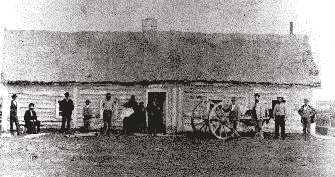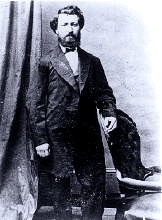Historic themes
Riel House National Historic Site
- The history of the Métis in Manitoba 1870-1900
- The Riel-Lagimodière Family in Red River and Manitoba
- Louis Riel, Métis leader and a founder of the Province of Manitoba
The history of the Métis in Manitoba 1870-1900
This period is known as the 'sombre years' for the Métis of Manitoba. In 1870, the Métis made up half of the population of the new province, and a prominent and prosperous part at that.

© Provincial Archives of Manitoba
Their language and property rights had just been guaranteed by the Canadian Government with the passage of the Manitoba Act, so their future in Manitoba seemed assured.
Manitoba's entry into Confederation in 1870, however, was accompanied by an influx of surveyors, government officials and settlers in search of opportunities. The Canadian Government and their local representatives opened up more land for immigrants-which meant breaking the Manitoba Act. The Government went back on its agreement with the Métis regarding their land rights.
By 1883, much of the land that had been occupied by Métis in 1870 was now controlled by others. The Métis experienced increased poverty and discrimination and by 1900 perhaps as many as 75 percent of the original Red River Métis had left Manitoba. The dispossessed often moved further west and established communitites such as Lac la Biche and Batoche, the site of the second Métis Resistance in 1885. Many of those who stayed integrated into French-Canadian and Anglo-Canadian communities.
The Riel-Lagimodière Family in Red River and Manitoba
Were it not for the fact that a member of the Riel-Lagimodière family became the principal leader of the Métis nation, this family was typical of the founding families of the Red River Settlement.
The French Canadian Lagimodières were originally from Maskinongé, near Trois-Rivières. Jean-Baptiste Lagimodière and his wife, Marie-Anne Gaboury, arrived in the Northwest in 1806, where Jean-Baptiste worked as a voyageur and trader. They moved to the Red River Settlement around 1814. Lagimodière continued to be involved in the fur trade and took up farming. It was during this time that their daughter Julie, Riel's future wife, was born.
Louis Riel Sr., a Métis, was born at Île-à-la-Crosse (present-day northern Saskatchewan) in 1817. His parents were the French-Canadian voyageur Jean-Baptiste Riel and Marguerite Boucher, a French-Dene-Métis. They had married according to the 'custom of the country'-a marriage practice which drew primarily on Aboriginal traditions, where the union was not sanctified by church or state, but considered legitimate and long term by the participants and their peers.
In 1844, Louis Riel Sr. married Julie Lagimodière in Saint Boniface. Their son, Louis, was born the same year in a house on the Lagimodière farm at the confluence of the Red and Seine rivers. By the 1850s, the Riel family had relocated to Saint Vital. They established their home at the present site of Riel House National Historic Site in 1864, shortly after Riel Sr.'s death.
Foreshadowing his son's political involvement, Louis Riel Sr. was a leader in the 1849 Métis resistance to the Hudson's Bay Company's fur trade and administrative monopoly. A local free trader, Pierre-Guillaume Sayer, was arrested and tried for violating the HBC monopoly by trading with the Americans. Although he was found guilty, his sentence was suspended, perhaps due to the armed Métis surrounding the courthouse. This pivotal decision was celebrated with shouts of "le commerce est libre" (we have free trade) from the Métis.
Louis Riel, Métis Leader and a Founder of the Province of Manitoba
Louis Riel was born in Saint Boniface in 1844 and was educated in Montréal. When he returned to the Red River Settlement in 1868, he found the community anxious and divided over its political future. Canada was negotiating the purchase of the Hudson's Bay Company territories, known as Rupert's Land, without any consideration being given to the wishes or rights of its inhabitants. The Métis, on one hand, were suspicious that the Canadian government intended to force them off the land that they had occupied for generations. A minority in the Settlement welcomed annexation by Canada, believing that political association with Canada would benefit them.
The conflict heightened in the fall of 1869 when surveyors from Canada entered the southern part of the Settlement and seemed to confirm the fears of the Métis. Louis Riel and 15 others stopped the surveying and blocked the Pembina Trail-the route north from the American border.

© Provincial Archives of Manitoba
Louis Riel was accorded the status of a Founding Father of Manitoba in 1992 by the Province in recognition of his role in bringing the province into Canada.
Riel and his followers then seized Upper Fort Garry, the Hudson's Bay Company trading post and centre of authority in the Red River Settlement. With strong Métis support, a provisional government was formed with John Bruce and then Louis Riel at its head. While the Métis militia protected the Settlement from Canadian annexation, Father Noël-Joseph Ritchot led a delegation to Ottawa to negotiate Manitoba's entry into Canada. Although Ritchot successfully negotiated most of the Métis rights, Riel was not granted the promised amnesty. He was forced into exile, and was unable to take his seat as a Member of Parliament in Ottawa despite being elected three times.
In the 1870s, Riel left his homeland and lived in the United States, becoming a U.S. citizen. He returned to Canada in 1884 to once again lead his people in the defence of their land and political rights. The armed resistance of 1885 met with some initial success, but the Métis were defeated by Canadian troops at Batoche in present-day Saskatchewan. Riel turned himself in and eloquently pleaded his cause and that of his people during his trial. He was nonetheless found guilty of treason by Canadian authorities and executed in Regina in November 1885.
- Date modified :